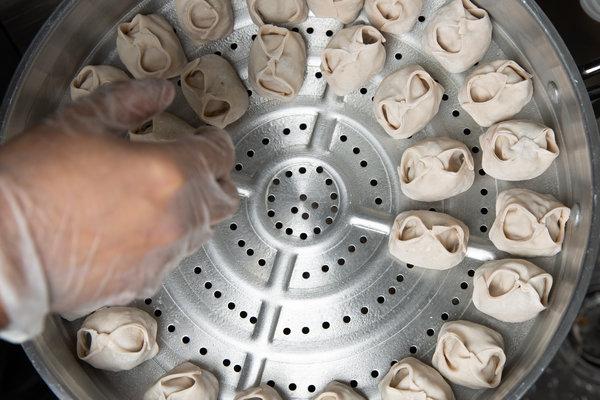Two years ago, Mohibullah Rahmati, known as Mo, bought a mail truck at a government auction, hoping to equip it with a kitchen and bring his mother’s Afghan recipes to the streets of New York.
She and his father had fled their hometown, Tashkurghan (today Kholm), in northern Afghanistan after the Soviet invasion of 1979. With two young children (Mo’s older brothers) in tow, they made their way to India, then Arizona, before settling in Woodside, Queens, where Mo was born.
At the time, Afghan refugees were just beginning to find their footing in the city, taking over the sidewalk pushcarts that were once a near-monopoly of the Greek immigrants who had arrived before them. They sold coffee and bagels, but never Afghan food.

The Nansense food truck specializes in Afghan comfort food like mantu, dumplings with sheer skins, corners pinched at the top.CreditCaitlin Ochs for The New York Times
Now, on the corner of 20th Street and Sixth Avenue in Chelsea, the Nansense truck offers mantu, dumplings with sheer skins, corners pinched at the top. Inside is ground beef at a plush burger-worthy ratio: 80 percent lean, 20 percent fat. Mr. Rahmati browns the meat unadorned, then works in salt, pepper, crushed coriander seeds and cilantro. This gets folded into thin won-ton wrappers along with curls of raw onion, which grow slack and faintly sweet as the dumplings steam.
The mantu are fortifying, the heat penned up inside the skins, which hiss when pierced. But what makes them great are their ornaments: garlicky yogurt, oddly punchy and soothing at once, and a rubble of split peas in a rich korma of tomato paste and onions caramelized to a near burn. There’s cumin in there, gently warming, along with the slightest shock of chile: a baring of the teeth.
The rest of the menu is devoted to more versions of korma, made with kofta — rough rounds of ground beef and onions bound by chickpea flour — chicken thighs cooked in their own fat, or potatoes and peas, melded but still distinct. Each comes in a box with kabuli, carrots and raisins given a gloss in a pan with cardamom and sugar, and a bracing fistful of raw red onions and tomatoes, piqued by lime, with a flutter of dried mint and cilantro.
One last dish is mashawa, a soup thick as stew and built for winter. Mung beans, black-eyed peas and chickpeas are softened and fused with rice, carrots, turnips and potatoes. It’s suffused with dill, which adds an unexpected sunniness. With each spoonful, I felt like I could walk a hundred miles — or sleep for hours.
Mr. Rahmati, 32, still lives in Woodside, in the building where he grew up, although his parents have moved to Flushing, where there’s a larger Afghan-born population. He struggled for months to get a mobile vendor permit, all the while supporting himself as an Uber driver.
Last January, he finally rolled out the mail truck-turned-food truck, now painted chocolate brown, with the name Nansense in big yellow block letters — a pun on naan, the Afghan word for bread. (The name is hidden in the logo, too, a grinning face whose eyes spell “naan” in Dari, with “sense” in English scrawled down the tongue.)
That first winter was rough. Mr. Rahmati woke at 4 every morning and headed to a commissary kitchen in Long Island City, Queens, to start preparing the day’s meals. Few customers were willing to wait on the sidewalk in the cold. So when the temperatures started dropping last month, he opened a weekend stand at Smorgasburg’s indoor market in Downtown Brooklyn.
But every Wednesday, the truck comes back out to Chelsea. Mr. Rahmati works the stoves alone, which for the time being limits his ambitions. He briefly offered a kebab burger on naan khasa, an Afghan flatbread, but couldn’t manage it without another cook to watch the grill.
The bread, furrowed and beautifully chewy, is still available, however. It, too, is a Rahmati production — it comes from New Kabul Bakery in College Point, Queens, which Mo’s older brothers, Wais and Abdul Rahmati, took over this year, with Abdul as head baker. The bread is tricky to make: You have to use all 10 fingers, pressing the dough away, then lifting back and pressing it away again, all down its length, so that pockets of air form, bringing lightness.
“I still can’t get it right,” Mo said with a laugh. “But my brother has mastered it.”



